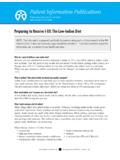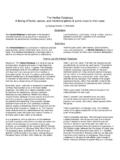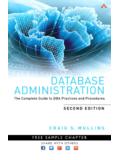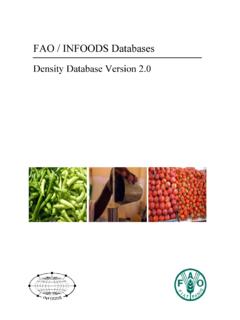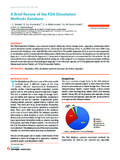Transcription of USDA Database for the Added Sugars Content of …
1 USDA Database for the Added Sugars Content of selected Foods Release 1. Prepared by Nutrient Data Laboratory Beltsville Human Nutrition Research Center (BHNRC). Agricultural Research Service (ARS). Department of Agriculture (USDA). February 2006. Department of Agriculture Agricultural Research Service Beltsville Human Nutrition Research Center Nutrient Data Laboratory 10300 Baltimore Avenue Building 005, Room 107, BARC-West Beltsville, Maryland 20705. Tel. 301-504-0630, FAX: 301-504-0632. E-Mail: Web site: Table of Contents Introduction ..1. Procedures ..1. Format of the Data References ..3. USDA Database for the Added Sugars Content of selected Foods .. 4. Baby foods .. 4.
2 Baked 7. Beef products .. 13. Beverages ..13. Breakfast 15. Cereal grains and pasta .. 15. Dairy and egg products .. 17. Fast Fats and oils .. 21. Finfish and shellfish products .. 23. Fruits and fruit juices .. 23. Lamb, veal and game products .. 27. Legumes and legume products .. 28. Meats, entrees, and sidedishes .. 30. Nut and seed products .. 30. Pork products .. 31. Poultry 31. Sausages and luncheon meats .. 31. 33. Soups, sauces and gravies .. 34. Spices and 37. 38. Vegetables and vegetable products .. 41. i USDA Database for the Added Sugars Content of selected Foods, Release 1 (2006). Introduction There is growing scientific interest in the levels of Added Sugars in the diet, especially as it relates to research concerning the relationship between sugar intake and health and obesity prevention (DGAC 2005).
3 The Nutrient Data Laboratory has developed a Special Interest Table to provide data for the Added Sugars Content of common foods, in support of nutrition research and monitoring objectives. Since there is no analytical method for distinguishing between Added Sugars and naturally occurring sugar , the Added Sugars values were calculated from Sugars listed as label ingredients and nutrient values for total Sugars and total carbohydrates for most processed foods. At the present time, no brand name foods are included in this table. Foods that do not contain carbohydrate, such as meats and oils, are not included. Also, foods that contain less than 2%. carbohydrate and have 0 total Sugars , such as most margarines and luncheon meats, are not included.
4 Procedures Guidelines followed in calculating Added Sugars were: Sugars and sweeteners: o The sweeteners listed below were considered to be Added Sugars in multi-ingredient foods such as baked goods, candies, and syrup-pack fruit. (When these sweeteners are listed individually in the table, the Added Sugars value is zero because the sugar is intrinsic to the food. However, if users of the table use these sweeteners as ingredients in recipes to calculate the Added sugar Content of multi-ingredient foods or for food intake surveys, the Added sugar value, Nut. No. 539, should be equal to the total sugar value, Nut. No. 269.). sugar [granulated (sucrose), brown, powdered and maple].
5 Mono- and disaccharides [ , fructose, lactose, maltose, glucose (dextrose)]. Single ingredient syrups (light corn, dark corn, high fructose corn, maple, malt, sorghum). Honey Molasses Some ingredients such as brown rice syrup, raw sugar , liquid sucrose, invert sugar and concentrated cane juice syrup are not available in SR. Added Sugars were calculated using an appropriate substitute ingredient. For example, brown sugar was substituted for raw sugar . o Ingredient sweeteners without carbohydrate carriers ( , 100%. aspartame used in commercial products) were considered to contribute 1. no Added Sugars to multi-ingredient foods that contained them as ingredients. Fruit juice concentrates: o If fruit juice concentrate is used as an ingredient and not reconstituted ( , in dry cereals, organic snack bars), the sugar it contains is counted toward Added Sugars .
6 O If reconstituted, the sugar in the concentrate is not counted towards Added Sugars . For example, if canned fruit is packed in fruit juice made from reconstituted pear juice concentrate, the pear juice concentrate plus water is considered to be equivalent to single strength fruit juice and therefore is not considered to contribute to Added Sugars . Organic acids ( , citric acid), when used as food ingredients, are not counted towards Added Sugars . sugar alcohols ( , mannitol, sorbitol, xylitol) are not included in Added Sugars . Oligosaccharides, such as found in corn syrup, are not included in Added Sugars . Format of the Table The table contains carbohydrate, total sugar , and Added sugar values for 2,038.
7 Foods across 23 food groups. The carbohydrate and total sugar values are taken directly from the USDA National Nutrient Database for Standard Reference, release 18 (SR). Values contain the same number of decimal places as those listed in SR. Added Sugars were calculated from total carbohydrate and total sugar values, using ingredient listings to identify Added sugar sources. Values for Added Sugars are reported to one less decimal place than the carbohydrate and total sugar values from which they were derived. Carbohydrate by difference is determined by subtracting the sum of ash, moisture, fat and protein from 100. In food composition analysis, moisture Content varies from sample to sample of the same food.
8 Therefore, if carbohydrate by difference was determined from an analytical sample with a different moisture Content than that of the sample analyzed for individual and/or total Sugars , the total Sugars value may be slightly greater than the carbohydrate. This would be most noticeable in foods where sugar is the only carbohydrate present. In addition, individual Sugars are summed to generate a total sugar value; system rounding may cause the cumulative total to exceed the carbohydrate value. The foods are arranged alphabetically within each food group. A unique NDB. number, a five-digit food identification code used in SR, identifies each food. Values are presented as grams per 100 grams of food.
9 The fields in the spreadsheet are as follows: 2. Field name Description NDB_No 5-digit Nutrient Databank number that uniquely identifies a food item FdGrp_Cd 4-digit code indicating food group to which a food item belongs FdGrp_Desc Name of food group Food Description Description of food item Carbohydrate, by Carbohydrate, by difference (g/100 g). difference Nutrient No. 205. Total Sugars Total Sugars (g/100 g). Nutrient No. 269. Added Sugars Added Sugars (g/100 g). Nutrient No. 539. Data Dissemination The USDA Database for the Added Sugars Content of selected Foods is . presented as a PDF file. The Adobe Acrobat Reader is required to view the report of the Database . In addition, the Database is available as a Microsoft.
10 Excel spreadsheet and is available for downloading from this Web site. References Dietary Guidelines Advisory Committee (DGAC). 2005. Report of the Dietary Guidelines Advisory Committee on the Dietary Guidelines for Americans, 2005. Department of Agriculture, Agricultural Research Service. 3. USDA Database for the Added Sugars Content of selected Foods, Release 1. Carbohydrate, Total Added by difference Sugars Sugars NDB No. Description g/100. Baby Foods 42150 Babyfood, apple yogurt dessert, strained 03167 Babyfood, apple-banana juice 03169 Babyfood, apple-cranberry juice 03289 Babyfood, apples with ham, strained 03115 Babyfood, apples, dices, toddler 42284 Babyfood, baked product, finger snacks cereal 43550 Babyfood, banana apple dessert, strained 42119 Babyfood, banana juice with low fat yogurt 43546 Babyfood, banana no tapioca, strained 03290 Babyfood, carrots and beef, strained 42316 Babyfood, carrots, toddler 03181 Babyfood, cereal, barley, dry 42285 Babyfood, cereal, brown rice, dry, instant 03185 Babyfood, cereal, mixed, dry 03188 Babyfood, cereal, mixed, with applesauce and bananas.
